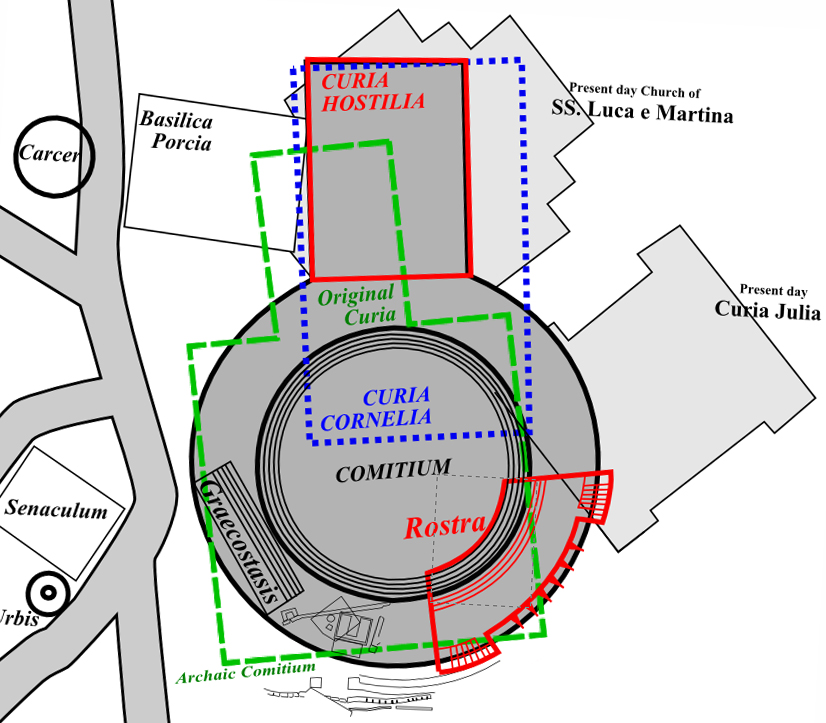Curia Cornelia on:
[Wikipedia]
[Google]
[Amazon]
 The Curia Cornelia was a place where the
The Curia Cornelia was a place where the
50.2-3
In 44 BC, the Curia was converted into a temple by Caesar during his redesign of the
Curia Cornelia
{{coord missing, Italy Buildings and structures completed in the 1st century BC Roman Forum Ancient Roman buildings and structures in Rome Rome R. X Campitelli Roman Senate
 The Curia Cornelia was a place where the
The Curia Cornelia was a place where the Roman Senate
The Roman Senate ( la, Senātus Rōmānus) was a governing and advisory assembly in ancient Rome. It was one of the most enduring institutions in Roman history, being established in the first days of the city of Rome (traditionally founded in ...
assembled beginning c. 52 BC. It was the largest of all the ''Curiae'' (Senate Houses) built in Rome. Its construction took over a great deal of the traditional comitium
The Comitium ( it, Comizio) was the original open-air public meeting space of Ancient Rome, and had major religious and prophetic significance. The name comes from the Latin word for "assembly". The Comitium location at the northwest corner of the ...
space and brought the senate building into a commanding location within the Roman Forum
The Roman Forum, also known by its Latin name Forum Romanum ( it, Foro Romano), is a rectangular forum (plaza) surrounded by the ruins of several important ancient government buildings at the center of the city of Rome. Citizens of the ancient ...
as a whole. It was the Senate House of the time of Julius Caesar
Gaius Julius Caesar (; ; 12 July 100 BC – 15 March 44 BC), was a Roman general and statesman. A member of the First Triumvirate, Caesar led the Roman armies in the Gallic Wars before defeating his political rival Pompey in a civil war, and ...
and is significant because its location was moved by him to diminish the Senate's dominance within the City and Republic.
History
In 80 BC,Lucius Cornelius Sulla
Lucius Cornelius Sulla Felix (; 138–78 BC), commonly known as Sulla, was a Roman general and statesman. He won the first large-scale civil war in Roman history and became the first man of the Republic to seize power through force.
Sulla had t ...
decided to enlarge the existing Curia to accommodate the doubling of senators in the Republic. He had to demolish the old Curia Hostilia
The Curia Hostilia was one of the original senate houses or "curiae" of the Roman Republic. It was believed to have begun as a temple where the warring tribes laid down their arms during the reign of Romulus (r. c. 771–717 BC). During the early ...
and the Comitium
The Comitium ( it, Comizio) was the original open-air public meeting space of Ancient Rome, and had major religious and prophetic significance. The name comes from the Latin word for "assembly". The Comitium location at the northwest corner of the ...
, but the name Hostilia was kept.
The Curia Hostilia was again destroyed during riots at the funeral of Publius Clodius Pulcher
Publius Clodius Pulcher (93–52 BC) was a populist Roman politician and street agitator during the time of the First Triumvirate. One of the most colourful personalities of his era, Clodius was descended from the aristocratic Claudia gens, one ...
, in 52 BC. It was rebuilt again by Faustus Cornelius Sulla, the son of Lucius Cornelius Sulla, and took the name Curia Cornelia.Cassius Dio
Lucius Cassius Dio (), also known as Dio Cassius ( ), was a Roman historian and senator of maternal Greek origin. He published 80 volumes of the history on ancient Rome, beginning with the arrival of Aeneas in Italy. The volumes documented the ...
, X50.2-3
In 44 BC, the Curia was converted into a temple by Caesar during his redesign of the
Roman Forum
The Roman Forum, also known by its Latin name Forum Romanum ( it, Foro Romano), is a rectangular forum (plaza) surrounded by the ruins of several important ancient government buildings at the center of the city of Rome. Citizens of the ancient ...
. It is not known when the building was finally torn down, but its location in relation to the Forum of Caesar
The Forum of Caesar, also known by the Latin Forum Iulium or Forum Julium, Forum Caesaris,Hornblower, Simon and Antony Spawforth. ''The Oxford Classical Dictionary''. 3d Ed. Oxford: Oxford University Press, 1996. was a forum built by Julius Caesa ...
made it more than likely that happened during or after the construction of the first Imperial Forum.
Finally, Caesar replaced the Curia Cornelia with the Curia Julia
The Curia Julia ( la, Curia Iulia, links=no, it, Curia Iulia, links=no) is the third named ''curia'', or senate house, in the ancient city of Rome. It was built in 44 BC, when Julius Caesar replaced Faustus Cornelius Sulla's reconstructed Curia ...
, which still stands, in 44 BC.
See also
References
External links
Curia Cornelia
{{coord missing, Italy Buildings and structures completed in the 1st century BC Roman Forum Ancient Roman buildings and structures in Rome Rome R. X Campitelli Roman Senate